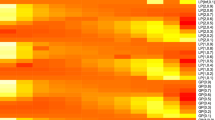Abstract
Obtaining relative weights in MCDM problems is a very important issue. The Ordered Weighted Averaging (OWA) aggregation operators have been extensively adopted to assign the relative weights of numerous criteria. However, previous aggregation operators (including OWA) are independent of aggregation situations. To solve the problem, this study proposes a new aggregation model – dynamic fuzzy OWA based on situation model, which can modify the associated dynamic weight based on the aggregation situation and can work like a “magnifying lens” to enlarge the most important attribute dependent on minimal information, or can obtain equal attribute weights based on maximal information. Two examples are adopted in this paper for comparison and showing the effects under different weights.
Similar content being viewed by others
References
Borcherding K, Epple T, Winterfeldt DV (1991) Comparison of weighting judgments in multi-attribute utility measurement. Manage Sci 37(12):1603–1619
Chen SM (2001) Fuzzy group decision making for evaluating the rate of aggregative risk in software development. Fuzzy Sets Syst 118:75–88
Chen YC (2002) An application of fuzzy set theory to the external performance evaluation of distribution centers in logistics. Soft Comput 6:64–70
Choi DY (1999) A new aggregation method in a fuzzy environment. Decis Support Syst 25:39–51
Choo EU, Wedley WC (1985) Optimal criteria weights in repetitive multicriteria decision making. J Oper Res Soc 37:527–541
Darmon RY, Rouzies D (1991) Internal validity assessment of conjoint estimated attribute importance weights. J Acad Marketing Sci 19(4):315–322
Dyer JS, Sarin RK (1979) Measurable multiattribute functions. Oper Res 27:810–822
Fuller R, Majlender P (2001) An analytic approach for obtaining maximal entropy OWA operator weights. Fuzzy Sets Syst 124:53–57
Jaynes ET (1989) Cleaning up mysteries: the original goal, maximum entropy and Bayesian methods. Kluwer, Dordrecht
Jaynes ET, Rosen krantz RD (1983) Papers on probability, statistics and statistical physics. D. Reidel, Dordrecht
Klir GJ (1988) Fuzzy sets, uncertainly and information. Prentice Hall, Englewood Cliffs
Klir GJ, Wierman MJ (1999) Uncertainty-based information, 2nd edn. Physica-Verlag, Germany
Lee HM (1996) Group decision making using fuzzy sets theory for evaluating the rate of aggregative risk in software development. Fuzzy Sets Syst 80:261–271
Mendel JM (2000) Uncertain rule-based fuzzy logic systems: introduction and new directions. Prentice Hall PTR, Upper Saddle River
Mesiar R, Saminger S (2004) Domination of ordered weighted averaging operators over t-norms. Soft Comput 8:562–570
Moshkovich HM, Schellenberger RE, Olson DL (1998) Data influences the result more than preferences: some lessons from implementation of multiattribute techniques in a real decision task. Decis Support Syst 22:73–84
Nutt PC (1980) Comparing methods for weighting decision criteria. OMEGA 8:163–172
O'Hagan M (1988) Aggregating template or rule antecedents in real-time expert systems with fuzzy set logic. In: Proceedings of 22nd Annual IEEE Asilomar conference on signals, systems, computers, Pacific Grove, pp 681–689
Pekelman D, Sen S (1974) Mathematical programming models for determination of attribute weights. Manage Sci 20(8):1217–1229
Ribeiro RA, Pereira RAM (2003) Generalized mixture operators using weighting functions: a comparative study with WA and OWA. Eur J Oper Res 145:329–342
Shannon CE (1948) A mathematical theory of communication. Bell Syst Tech J 27:379–423
Shoemaker PJH, Carter WC (1982) An experimental comparison of different approaches to determining weights in additive utility models. Manage Sci 28:182–196
Smolikova R, Wachowiak MP (2002) Aggregation operators for selection problems. Fuzzy Sets Syst 131:23–34
Solymosi T, Dombi J (1986) A method for determining the weights of criteria: the centralized weights. Eur J Oper Res 26:35–41
Weber M, Eisenfhr F, von Winterfeldt D (1988) The effects of splitting attributes on weights in multiattribute utility measurement. Manage Sci 34:431–445
Yager RR (1980) On a general class of fuzzy connectives. Fuzzy Sets Syst 4:235–242
Yager RR (1988) Ordered weighted averaging aggregation operators in multi-criteria decision making. IEEE Trans Syst Man Cybern 18:183–190
Yager RR (1991) Connectives and quantifiers in fuzzy sets. Fuzzy Sets Syst 40:39–75
Yager RR, Kacprzyk J (1997) The ordered weighted averaging operators. Kluwer, Boston
Zadeh LA (1965) Fuzzy sets. Inf Control 8:338–353
Zhang D, Yu PL, Wang PZ (1992) State-dependent weights in multicriteria value functions. J Optimization Theory Appl 74(1):1–21
Zimmermann HJ, Zysno P (1980) Latent connectives in human decision making. Fuzzy Sets Syst (North-Holland) 4:37–51
Author information
Authors and Affiliations
Corresponding author
Rights and permissions
About this article
Cite this article
Chang, JR., Ho, TH., Cheng, CH. et al. Dynamic fuzzy OWA model for group multiple criteria decision making. Soft Comput 10, 543–554 (2006). https://doi.org/10.1007/s00500-005-0484-x
Published:
Issue Date:
DOI: https://doi.org/10.1007/s00500-005-0484-x




